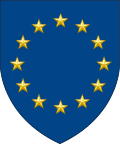Slovenian Armed Forces
The Slovenian Armed Forces or Slovenian Army (SAF; Slovene: Slovenska vojska; [SV]) are the armed forces of Slovenia. Since 2003, it is organized as a fully professional standing army. The Commander-in-Chief of the SAF is the President of the Republic of Slovenia, while operational command is in the domain of the Chief of the General Staff of the Slovenian Armed Forces.
| Slovenian Armed Forces | |
|---|---|
| Slovenska vojska | |
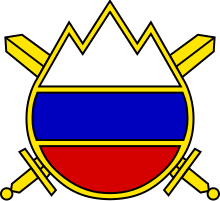 Slovenian Army emblem | |
 Flag of the Slovenian Armed Forces Anthem of the Slovenian Army:
| |
| Founded | 1991 |
| Service branches | Slovenian Ground Force Slovenian Air Force and Air Defence Slovenian Navy |
| Headquarters | Ljubljana |
| Leadership | |
| Commander-in-Chief | |
| Minister of Defence | |
| Chief of the General Staff | |
| Manpower | |
| Conscription | Abolished in 2003 |
| Fit for military service | 402,484 (2009 est.)[1], age 16-49 |
| Active personnel | ~6,700 [2] (as of May 2018) |
| Reserve personnel | ~1,000 (contract reserve soldiers) ~25.000 (tactical reserve) |
| Expenditures | |
| Budget | 548 milion €[3] |
| Percent of GDP | 1.04% (2019)[3] |
| Related articles | |
| History | Slovenian War of Independence Slovenian Territorial Defence |
| Ranks | Slovenian military ranks |
History
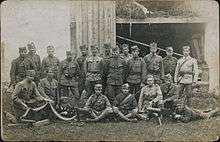
The military history of Slovenia spans less than a hundred years. Following the disintegration of the Austrian-Hungarian Empire at the end of World War I, the Duchy of Styria was divided between the newly established states of German Austria and the State of Slovenes, Croats and Serbs. Rudolf Maister, a Slovene major of the former Austro-Hungarian Army, liberated the town of Maribor in November 1918 and claimed it for the State of Slovenes, Croats and Serbs. After a short fight with German Austrian provisional units, the current border was established, which mostly followed the ethnic-linguistic division between Slovenes and ethnic Germans in Styria.
The current Slovenian Armed Forces are descended from the Slovenian Territorial Defence (Teritorialna Obramba Republike Slovenije; or Slovene TO), formed in 1991 by fusion of Territorial Defence (formed in 1968 as a paramilitary complement to the regular army of the former Yugoslav within the territory of Slovenia) with secret alternative command structure, known as the Manoeuvre Structures of National Protection (Manevrska struktura narodne zaščite, or MSNZ), which was an existing but antiquated institution, (unique to Slovenia), intended to enable the republic to form an ad hoc defence structure, akin to a National Guard. It was of negligible importance prior to 1990, with antiquated weapons and few members.
When Slovenia declared independence at the onset of the Yugoslav Wars in 1991, the Slovenian Territorial Defence and the Slovenian police comprised the majority of forces engaging the Yugoslav People's Army during the Ten-Day War. The Slovenian Armed Forces were formally established in 1993 as a reorganization of the Slovenia Territorial Defence Force.
Current status
.jpg)
After 1993, the Slovenian Armed Forces had relied on mandatory military service, with conscripts receiving 6–7 months of training. In 2003, the Slovenian Government abolished conscription and as of July 2004, the Slovenian Armed Forces had been almost completely reorganised into a professional army now based on volunteers. Currently there are approximately 7,300 active troops and approximately 1,500 in reserve, reduced from 55,000 personnel during conscription.
A major reorganization of the Slovenian Armed Forces is currently underway[4] with a goal making them more effective and cheaper. More than half of all commands have been disbanded which has made commanding the subordinated units easier and faster. Soldiers are to be located nearer to their homes in order to minimize travel costs. Since the Slovenian Armed Forces do not have enough modern armored vehicles to maintain three motorized battalions fulfilled at every time, one Wheeled Combat Vehicles Company and one Tank Company have been organized within the Logistics brigade, which now lends vehicles to any of four newly formed infantry regiments, regarding to the regiments' needs. Reorganization also transformed 72nd Brigade from a support unit to a combat unit and thus equaled it with the 1st Brigade. Both brigades were added support elements, such as Air Defense, Artillery, Intelligence, etc. The operational units now consist of Special Operations Unit, Naval Division, an Aviation Regiment and three brigades, the 1st (responsible for western Slovenia), 72nd (responsible for eastern Slovenia) and Logistics Brigade.
NATO membership

As part of the former Socialist Federal Republic of Yugoslavia, Slovenia was never a member of the Warsaw Pact. Today, the foreign policy priority of NATO membership drives Slovenia's defense reorganization. Once many countries lifted the arms embargo on Slovenia in 1996, the country embarked on a military procurement program to bolster its status as a NATO candidate and to aid its transformation into a mobile force. Active in the SFOR deployment in Bosnia and Herzegovina, Slovenia is also a charter member of Partnership for Peace and a regular participant in PfP exercises. The United States provides bilateral military assistance to Slovenia, including through the International Military Education and Training (IMET) program, the State Partnership Program (aligned with Colorado), and the EUCOM Joint Contact Team Program.
Slovenia formally joined NATO in March 2004.[5] The transition of its armed forces from a primarily conscript-based territorial defense organization to a professional force structure has the ultimate goal of creating NATO-interoperable combat units able to operate on an even par with units from other NATO armies. Implementation of interoperability objectives as determined by the Planning and Review Process (PARP) and the Individual Partnership Program (IPP) as part of Slovenia's PfP participation proceeds. Slovenia's elite units already train with and are integrated into international units including NATO members—for example as part of SFOR and on Cyprus. Its elite mountain troops will be assigned to the Multinational Land Force peacekeeping battalion with Italy, Hungary, and Croatia. Slovenia hosted its first PfP exercise in 1998--"Cooperative Adventure Exchange"—a multinational disaster-preparedness command post exercise involving almost 6,000 troops from 19 NATO and PfP member nations.
Slovenian soldiers are a part of international forces serving in Bosnia and Herzegovina, Kosovo, Afghanistan,[6] Iraq, Chad, and Lebanon. They have also served in Cyprus and the Golan Heights as a part of UNFICYP and UNDOF respectively.
Slovenia hosts Multinational Centre of Excellence for Mountain Warfare (MN COEMW; Slovene: Večnacionalni center odličnosti za gorsko bojevanje), one of NATO Centres of Excellence, located in Bohinjska Bela, Slovenia. It is "responsible for training individuals and units for operation in the mountains and other terrains difficult to pass".[7]
Organization
The Slovenian Armed Forces are organized as single-branch armed forces with the army as their primary component. The personnel is divided into three categories:
- professional soldiers (full-time soldiers)
- contract reserve soldiers (serve up to 30 days per year)
- voluntary recruits (basic training)
Order of Battle
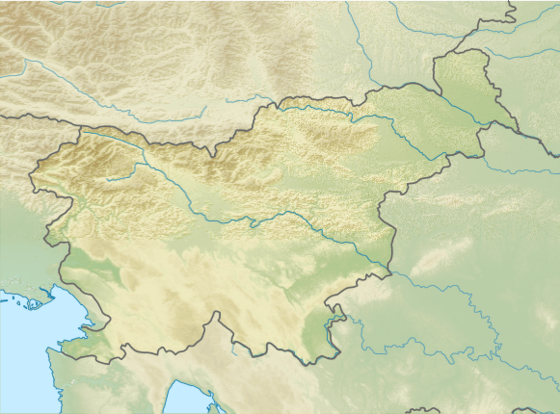
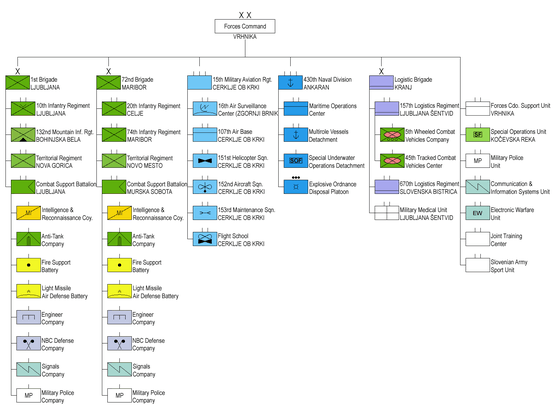
- General Staff of the Slovenian Armed Forces, in Ljubljana
- Military Orchestra
- Protocol Unit
- Joint Operations Center
- Situation Monitoring Section
- Movement Coordination Section
- Operations Management Section
- Support Branch
- Force Command, in Vrhnika
- Forces Command Support Unit, in Vrhnika
- Military Police Unit
- Electronic Warfare Unit
- Communication and Information Systems Unit
- Combined Arms Training Center
- 1st Brigade, in Ljubljana
- 10th Infantry Regiment, in Ljubljana
- 4x Infantry Companies
- Headquarters and Logistic Company
- 132nd (Mountain) Infantry Regiment, in Bohinjska Bela
- 4x Mountain Infantry Companies
- Headquarters and Logistic Company
- Multinational Centre of Excellence for Mountain Warfare
- Territorial Regiment, in Nova Gorica
- Combat Support Battalion, in Ljubljana
- Intelligence and Reconnaissance Company
- Anti-Tank Company, with Spike MR/LR ATGMs
- Fire Support Battery, with TN90 155mm towed howitzers and MN9 120mm mortars
- Light Air Defense Missile Battery, with Giraffe radar and Igla-2 MANPADS
- Engineer Company
- Nuclear, Biological, Chemical Defense Company
- Signals Company
- Military Police Company
- 10th Infantry Regiment, in Ljubljana
- 72nd Brigade, in Maribor
- 20th Infantry Regiment, in Celje
- 4x Infantry Companies
- Headquarters and Logistic Company
- 74th Infantry Regiment, in Maribor
- 4x Infantry Companies
- Headquarters and Logistic Company
- Territorial Regiment, in Novo Mesto
- Combat Support Battalion, in Murska Sobota
- Intelligence and Reconnaissance Company
- Anti-Tank Company, with Spike MR/LR ATGMs
- Fire Support Battery, with TN90 155mm towed howitzers and MN9 120mm mortars
- Light Air Defense Missile Battery, with Giraffe radar and Igla-2 MANPADS
- Engineer Company
- Nuclear, Biological, Chemical Defense Company
- Signals Company
- Military Police Company
- 20th Infantry Regiment, in Celje
- Logistic Brigade, in Kranj
- 157th Logistics Regiment, in Šentvid
- 1st Vehicle Maintenance Company
- 2nd Vehicle Maintenance Company
- 3rd Weapons Maintenance Company
- 5th Wheeled Combat Vehicles Company
- 45th Tracked Combat Vehicles Center
- Infrastructure Maintenance
- Spare Parts Storage and Distribution Unit
- 670th Logistics Regiment, in Slovenska Bistrica
- Service Company
- Supply Company
- 1st Transport Company
- 2nd Transport Company
- Fixed Supply Company
- Driving School
- Fuel Distribution
- Uniforms and Equipment Distribution
- Medical Unit, in Šentvid
- Medical Logistic Center
- Medical Center
- Medical Company West
- Medical Company East
- Medical Hospital - Role 2 Military Treatment Facility
- Veterinary Service
- Laboratory for Nuclear, radiological, chemical and biological defense
- 157th Logistics Regiment, in Šentvid
- 15th Wing, at Cerklje ob Krki Air Base
- 16th Airspace Control and Reporting Centre, in Zgornji Brnik
- Air Space Surveillance and Control Center, reports to NATO's Integrated Air Defense System CAOC Torrejón, in Spain
- 1st Radar Station, in Vrhnika, with Ground Master 403
- 2nd Radar Station, in Hočko Pohorje, with Ground Master 403
- Mobile Radar Company, in Soteska
- Logistic Company
- 107th Air Base, at Cerklje ob Krki Air Base
- Cerklje ob Krki Air Base Support Company
- 151st Helicopter Squadron, at Cerklje ob Krki Air Base
- Bell 412 Helicopter Section
- AS532 AL Cougar Helicopter Section
- Aero-technical Company
- 152nd Aircraft Squadron, at Cerklje ob Krki Air Base
- 1st PC-9M Hudournik Fighter Planes Section
- 2nd PC-9M Hudournik Fighter Planes Section
- Air Transport Section, with PC-6 Porter and Falcon 2000 EX
- Aero-technical Company
- 153rd Aircraft Maintenance Squadron, at Cerklje ob Krki Air Base
- Aeronautical-technical Engineering
- Aircraft Maintenance Company
- Helicopter Maintenance Company
- Flight School, at Cerklje ob Krki Air Base
- 1st Zlín Z-242 Training Planes Section
- 2nd Zlín Z-242 Training Planes Section
- Bell 206 Training Helicopter Section
- Aero-technical Company
- 16th Airspace Control and Reporting Centre, in Zgornji Brnik
- 430th Naval Division, in Ankaran
- Naval Operations Center
- Multirole Vessels Detachment
- Special Underwater Operations Detachment
- Explosive Ordnance Disposal Platoon
- Special Operations Unit, in Kočevska Reka
- Special Operations Company
- Combat Service Support Company
- Special Operations Training Center
- Specialized Unit of the Military Police, in Ljubljana
- "FIST" Platoon - Specialized Unit for Special Tactics
- EOD Detachment
- Investigations Detachment
- Military Education Center, in Maribor
- Command and Staff School, in Maribor
- Officer School, in Maribor
- Non-Commissioned Officer School, in Maribor
- Foreign Languages School, in Begunje na Gorenjskem
- Basic Military Skills Center, in Vipava
- Library, Information and Publishing Center, in Ljubljana
- E-Learning Section, in Maribor
- Military Museum of the Slovenian Armed Forces, in Maribor
- Slovenian Army Sport Unit
Military bases
Military airports
The Slovenian army currently maintains one military airport Cerklje ob Krki near town of Brežice. The airport's official name is Cerklje ob Krki Airbase.
The others that are partially military are:
- Ljubljana Airbase shares the airport with Ljubljana International Airport. One helicopter Bell 412 is stationed there for mountain rescue.
International cooperation
Slovenia is part of the United Nations, NATO and the European Union, and supports the efforts of these organisations in peacekeeping operations and humanitarian activities. The Slovenian Armed Forces have been participating in various missions since 1997, when the first unit was deployed to Albania for a humanitarian operation. Slovenia has continued its efforts in international cooperation by participating in various missions in Afghanistan, Iraq, Cyprus, Pakistan and other countries. The total amount of sent personnel through Slovenias contribution to missions is more than 15,000, but some speculations are over 20,000 personnel.
Current operations
| Deployment | Organization | Operation | Personnel[8] |
|---|---|---|---|
| Afghanistan | NATO | Resolute Support Mission | 15 |
| Bosnia and Herzegovina | NATO | Joint Enterprise | 4 |
| Kosovo | NATO | KFOR | 384 |
| Macedonia | NATO | Joint Enterprise | 2 |
| Serbia | NATO | Joint Enterprise | 1 |
| Bosnia and Herzegovina | EU | EUFOR Althea | 12 |
| Mali | EU | EUTM Mali | 5 |
| Lebanon | UN | UNIFIL | 37 |
| Syria | UN | UNTSO | 7 |
| Italy | EU | EU Navfor Med | 6 |
| Iraq | CJTF | Operation Inherent Resolve | 8 |
| Latvia | NATO | NATO Enhanced Forward Presence | 80 |
Modernisation
Ground force
The Slovenian Armed Forces sent a request for 14 new Pandur EVO armoured vehicles in late 2019. As the SAF already operate 85 Pandur I (Valuk), which is from the same family of vehicles and is the main vehicle of the army and were bought from the same company as the new ones which was Steyr (Austrian) in the past and today General Dynamics Land Systems (American), the company is offering the vehicles to the army as they know it will have all requirements for the SAF that the old ones lacked which is troop space, protection, modern electronics and RCWS. Unlike the Austrian Pandur EVO, which is only armed with 12.7mm M2 Browning HMG, some Slovenian Pandur EVO will be equipped with 40mm Heckler & Koch GMG. The Austrian government is offering a government to government contract with the Slovenian government to make the purchase cheaper. The director of GDELS confirmed there will be no corruption or problems with the purchase as they have done purchases in the past with no problem, as the SAF is an important customer to them. The 14 vehicles will fulfil 1 company of troops and the cost is estimated around 40 million Euros. The purchase is currently on standby as they are waiting for the decision of the new government for the purchase. Delivery to take place between 2020–2021.
Since the new defence minister wanted and still wants to finish the purchase of Boxer (armoured fighting vehicle) and the new general also being interested in it, if they solve the pricing problems it is possible that they will buy 56 Boxer vehicles instead of 14 Pandur EVO.
Alongside the 14 Pandur EVO armoured vehicles, they will be joined by 38 Joint Light Tactical Vehicle which the deliverey date was said to be in 2021-2023 but has changed as productions etc. is going better than expected and therefor already being 12 Joint Light Tactical Vehicles in the army in 2020 which are intended to replace the Humvee. The cost for the purchase was 32 million Euros. They will be armed with 12.7mm M2 Browning HMG and some with 40mm Heckler & Koch GMG, 1 company being an anti-tank company equipped with Spike (ATGM) LR/MR missiles.
The ministry of defence of RS said in 2020 that the artillery will be equipped with self propelled howitzers which will increase its firepower, speed and efficiency. The German Panzerhaubitze 2000 is a high contender in this purchase which will be done after the purchase of the Pandur EVO armoured vehicles in 2022–2023.
As Slovenian ground force already has 11 Roland (missile) II short range air defences, the ministry of defence of RS said that they will make a purchase of an short to medium range air defence system with integrated radar which reduce the need for trucks to tow a radar for the air defence system. Purchase will be done in around 2024.
Air force
The ministry of defence of RS said that they will start to retire some aircraft in the fleet to lower maintenance costs, while purchasing large sized military transport aircraft. The purchase of a large sized military transport aircraft was already being done in 2007 between the Italian Alenia C-27J Spartan and the Spanish EADS CASA C-295. Both were tested in Cerklje ob Krki Airport military airport by the Slovenian pilots and the decision was made to buy the Spanish C-295 but in that time one C-295 crashed down and they cancelled the purchase.
Navy
The navy will receive 2 underwater vessels 1 being remote controlled and 1 man operated.
Gallery
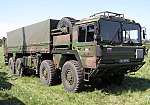 Slovenian MAN Army Truck
Slovenian MAN Army Truck Slovenian Armoured Vehicles
Slovenian Armoured Vehicles Slovene Army Humvee on patrol in Kosovo
Slovene Army Humvee on patrol in Kosovo Slovenian Convoy in Kosovo KFOR Mission
Slovenian Convoy in Kosovo KFOR Mission AS AL 532 Cougar of the Slovenian Air Force
AS AL 532 Cougar of the Slovenian Air Force 10412 class patrol boat Triglav with Super Dvora Mk II-class patrol boat Ankaran
10412 class patrol boat Triglav with Super Dvora Mk II-class patrol boat Ankaran
References
- "The World Factbook - Manpower fit for military service". www.cia.gov. Archived from the original on 13 May 2009.
- "About the Slovenian Armed Forces". www.slovenskavojska.si. Retrieved 6 June 2018.
- "Defence Expenditure of NATO Countries (2012-2019)" (PDF). NATO Public Diplomacy Division. 25 June 2019. Retrieved 31 August 2019.
- http://www.mo.gov.si/fileadmin/mo.gov.si/pageuploads/pdf/ministrstvo/SOPR2013_2018.pdf
- http://www.nato.int/docu/update/2004/03-march/e0329a.htm
- The Slovenia Times - Daily News Archived 14 June 2011 at the Wayback Machine
- Slovenian Armed Forces. "Multinational Centre of Excellence for Mountain Warfare". Slovenian Armed Forces. Archived from the original on 24 February 2012. Retrieved 28 January 2012.
- "Slovenian Armed Forces - International operations and missions". www.slovenskavojska.si. Retrieved 20 March 2018.
Further reading
- Furlan, Branimir (2013). "Civilian Control and Military Effectiveness: Slovenian Case," Armed Forces & Society 39, No. 3, pp. 434–449.
External links
| Wikimedia Commons has media related to Slovenian Armed Forces. |
- Official page (in English)
- Slovenian Ministry of Defence official site (in English)
- Slovenian Air Force
- Slovenian Armed Forces/Slovenska vojska
